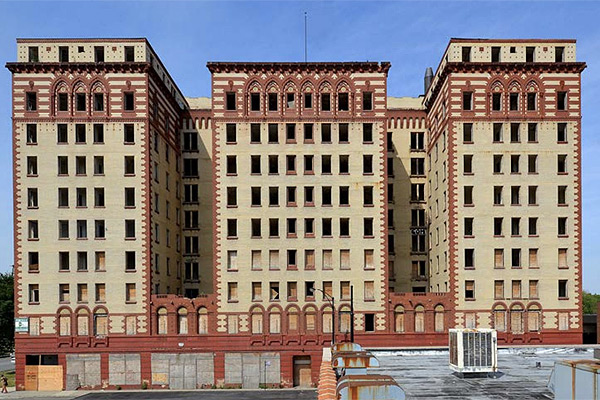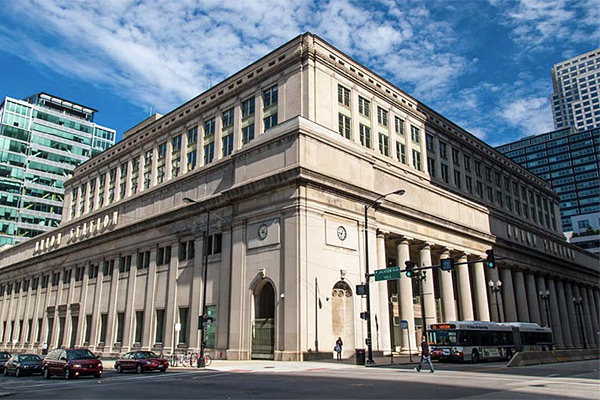While Chicago is known around the globe for its contribution to architecture, the city’s lesser known historic buildings are too often demolished. Each spring the group Preservation Chicago seeks to raise awareness for some of these buildings by unveiling a list of what it believes to be the city’s seven most endangered historic sites. This year’s list features buildings throughout the city, but emphasis is placed on important structures located on the city’s South Side.
Here’s a look at this year’s most endangered buildings and what Preservation Chicago suggests can be done to save them.
Jackson Park, Midway Plaisance, and South Shore Cultural Center
Jackson Park makes a repeat appearance on Preservation Chicago’s list in 2018 as plans for the Obama Presidential Center and overhaul of the Jackson Park Golf Course progress. For more than three years, Preservation Chicago executive director Ward Miller has warned of the extensive alterations to the park, which would see hundreds of trees removed and affect the integrity of Frederick Law Olmsted’s vision for the lakefront site.
While Miller says that his group supports the construction of the Obama Presidential Center in Chicago, he suggests that both the president’s foundation and the powers behind the golf-course plan should consider different locations. “If you need a PGA golf course in Chicago, why not look to the former U.S. Steel South Works site,” Miller said, referring to the former 400-acre lakefront industrial site on the Far South Side. In addition to the park itself, Preservation Chicago also highlights the Midway Plaisance and South Shore Cultural Center, which are both slated for big changes. The Obama Foundation has proposed a parking garage on the eastern end of the Midway Plaisance, while the South Shore Nature Sanctuary and grounds outside of the South Shore Cultural Center are included in the new Jackson Park Golf Course plan.

James R. Thompson Center
This postmodern Loop structure built by the State of Illinois in the early-mid ‘80s was highlighted on Preservation Chicago’s list of most endangered buildings in 2016, but it returns once more as the debate over its future continues. Governor Rauner proposed the idea of selling the Thompson Center back in 2015, suggesting that the sale would net the state over $200 million while also avoiding millions in deferred maintenance bills.
While the structure, with its uniquely shaped dome and pastel colors, is a polarizing one to passersby, many in the architecture community acknowledge the building’s place in Chicago’s architectural history. Preservation Chicago also views the Thompson Center as being significant—so much so that the group encourages the city to landmark the building to prevent its demolition. The group also suggests that the city and state consider architect Helmut Jahn’s proposal to add a tower addition to the site, which would make preservation feasible while also adding additional capacity for revenue generation.

William Rainey Harper High School
This historic building is just one of four Chicago Public School locations in Englewood that the city plans to close in coming months, causing uncertainty about the future of the Prairie style structure. The building was designed in the first decade of the 20th century by Dwight Perkins, a noted Chicago architect of the Prairie School movement who is also responsible for Carl Schurz High School and the Lincoln Park Zoo’s lion house. Miller highlights the school’s high quality craftsmanship and exterior ornamentation as being landmark-worthy. Preservationists worry that the building’s vacancy will lead to neglect and disrepair.

Washington Park Substation
This former South Side electrical substation has been left to deteriorate over many years and it is now surrounded by construction fencing, leading preservationists to believe that it may soon be demolished. The building was constructed in the 1930s by Commonwealth Edison at the height of the Art Deco period, but Preservation Chicago highlights the structure for its blend of styles. Architect Hermann von Holst designed the building combining features from the Prairie School, Art Deco, and Classical Revival movements into one.
Miller notes that the building is currently for sale and suggests that it would be a good candidate for adaptive reuse.

Woodruff Arcade Building
This unique commercial complex with its indoor retail spaces represents a bygone era, but Miller says that this is why the Edgewater building is worth saving. The masonry building dates back to the early 1920s, but a developer is seeking its demolition to build a newer, more profitable structure at the site. Miller notes the rarity of vintage shopping arcades but also the quality of materials and craftsmanship that went into constructing the building.
Citing an online petition which has gathered nearly 800 signatures, Miller believes that the surrounding community supports a preservation solution for the Woodruff Arcade. However, Preservation Chicago notes that the building’s new owner has not appeared to entertain the idea of preserving the building’s facade or interior elements for the new seven-story building planned for the site.

Hotel Guyon
Located in West Garfield Park, this historic hotel is just one piece of what was once a bustling commercial corridor along Washington Boulevard. Miller notes that its entry on this year’s list marks the third time that the building has been highlighted by Preservation Chicago as being one of the city’s most endangered historic buildings. Constructed in the 1920s in the Moorish Revival style, preservationists worry that the building may eventually be demolished due to neglect and safety concerns.
Instead of demolition, Miller suggests that the ten-story structure be repurposed as affordable housing.

Chicago Union Station
Amtrak, Union Station’s owner and operator, has been investing millions into renovating and improving the station’s grand open spaces and lounges, but preservationists are concerned about a new plan that would see two towers built atop the historic rail station. While rail hubs were once common in Chicago, Miller notes that Union Station is the last of its kind and that the loss of its grand concourse in the 1960s makes the existing terminal even more important.
Miller highlights the station’s connection to architect and Chicago city planner Daniel Burnham. The firm responsible for the station, Graham, Anderson, Probst, and White, is a direct descendant of Burnham’s firm. And with such a rich history combined with its rarity, Miller questions whether it’s appropriate to build newer, more contemporary towers on top of the existing structure. “When we’ve destroyed so much, do we really need to be building on top of our Chicago landmarks?”

Chicago's brick-paved streets and alleys
For this year’s list, Preservation Chicago added one more point to its list of endangered sites, but instead of highlighting a particular building, the group looks to the city’s network of paved streets and alleys. When roads are damaged during the winter months, sometimes the older, brick roads underneath are exposed, offering a glimpse into the past. Miller says that the city embraces these older streets and sidewalks paved with brick as the material not only has an aesthetic appeal, but it also helps to reduce vehicle speed. Miller also suggests that brick as a road construction material is “earth friendly” for its durability and for being water permeable.



